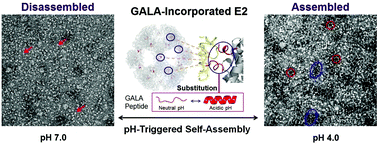Design of a reversible inversed pH-responsive caged protein†
Abstract
Controlling the self-assembly behavior of caged proteins expands their potential applications in nanotechnology. While the structure of a caged E2 protein from pyruvate dehydrogenase is inert to any pH change, the incorporation of switchable GALA peptide that undergoes a coil-to-helix transition at acidic pH modulates its self-assembly property. By substituting the native α-helix at the C-terminus of the E2 protein with the GALA peptide, we report the first engineered caged protein with reversible inversed pH-responsive behavior. The redesigned caged E2 protein assumes an assembly profile that is distinct from the native state; it disassembles at pH 7.0 and self-assembles at pH 4.0 in a reversible manner. This unique reversible pH trigger suggests the applicability of the self-assembly control on other multi-subunit macromolecules.


 Please wait while we load your content...
Please wait while we load your content...